Birds are fun to watch, but not just because they’re pretty. They have many interesting behaviors. Each bird species has different ways of taking care of their basic needs.
Types of behaviors
On this page:
- Food behaviors
- Interactions with other birds
- Mourning
- Migration
On separate pages
Finding food
We love watching birds, especially sparrows, doing their scratching “dance” to unearth insects or seeds. Leaf litter is a rich source of food, but this is too often missing in conventionally sterile home landscapes.
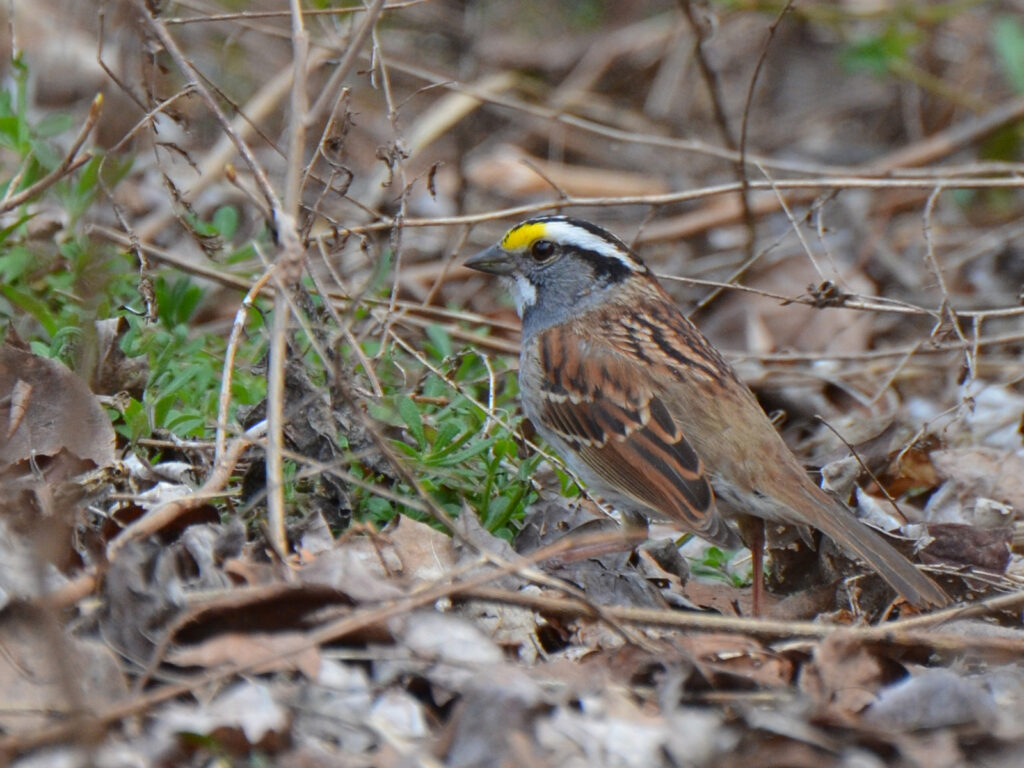
Fighting for food
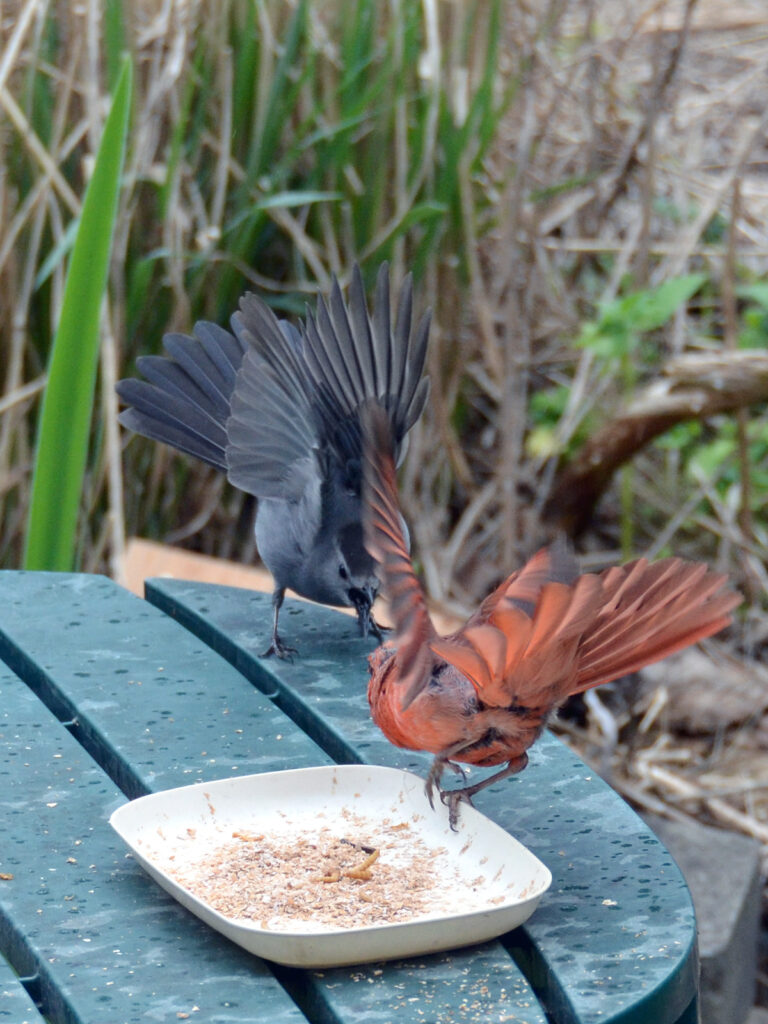
There’s often a lot of competition for food, here for coveted mealworms, especially when birds are feeding babies. This happens more often with feeders, such as with this mealworm feeder. These fights can get quite contentious, though never resulting in injury.
We’ve now started setting out multiple dishes of mealworms to reduce the competition.
In general, though, we try to provide many natural sources of food (native plants!) where there is less direct competition.
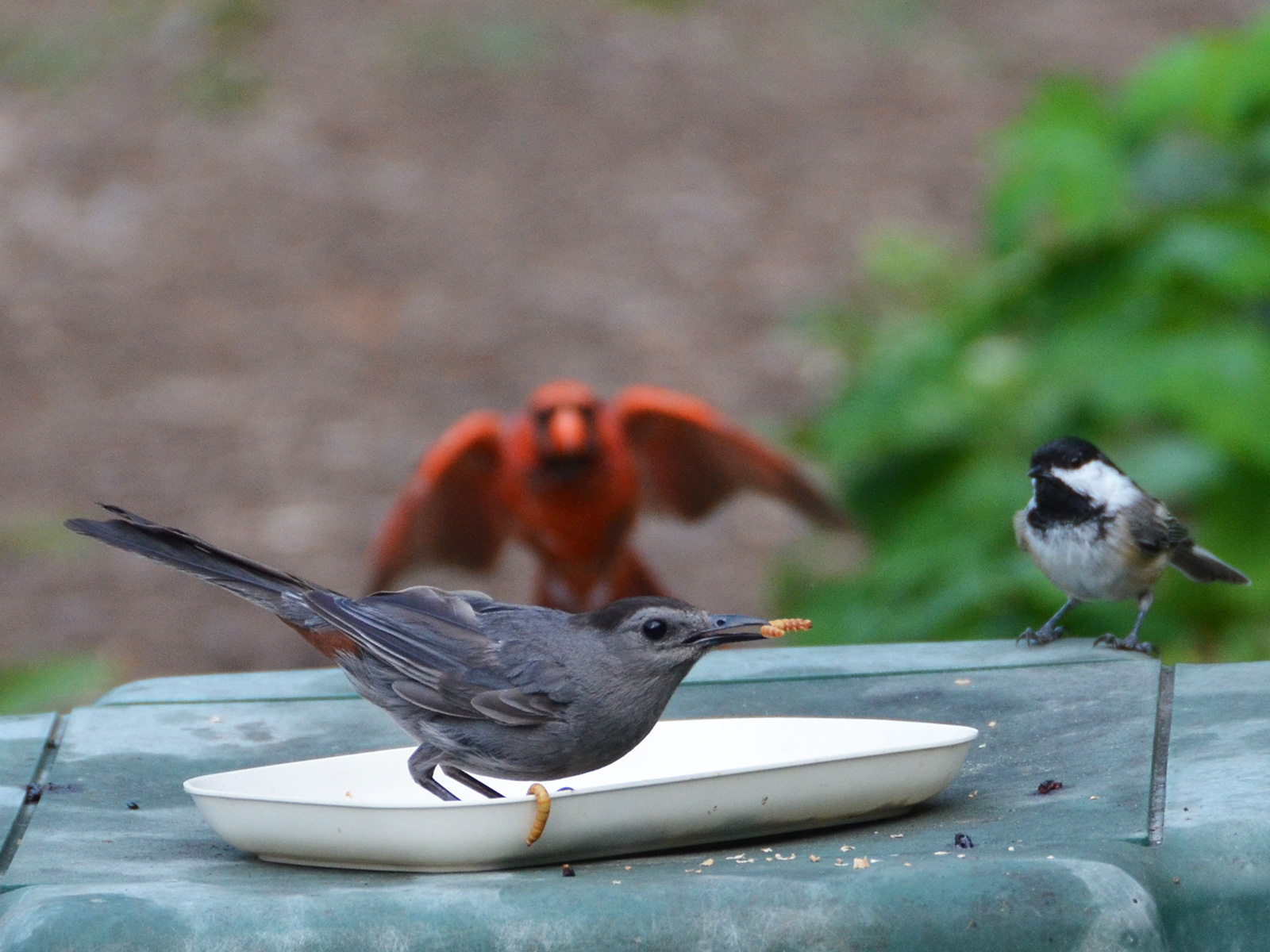
Caching: Saving for for later
Everyone knows that squirrels “squirrel away” nuts and acorns for the winter, but birds do this, too! It’s been interesting watching them cache extra food items around the yard. Certain that our five chickadees couldn’t possibly fit all the mealworms they were taking into their little tummies, I watched one closely and saw him spending some time on an old hibiscus seedhead. Sure enough, when he left, I went over and found the mealworm neatly tucked in! I’ve also seen chickadees checking out hollow plant stalks looking for food.
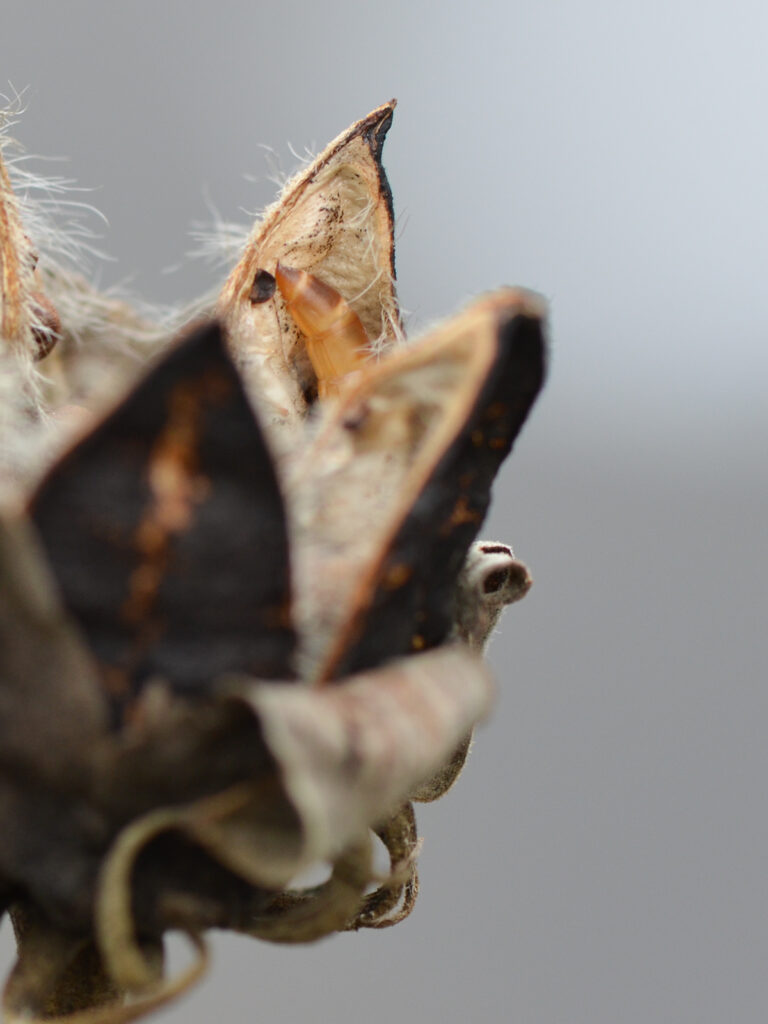
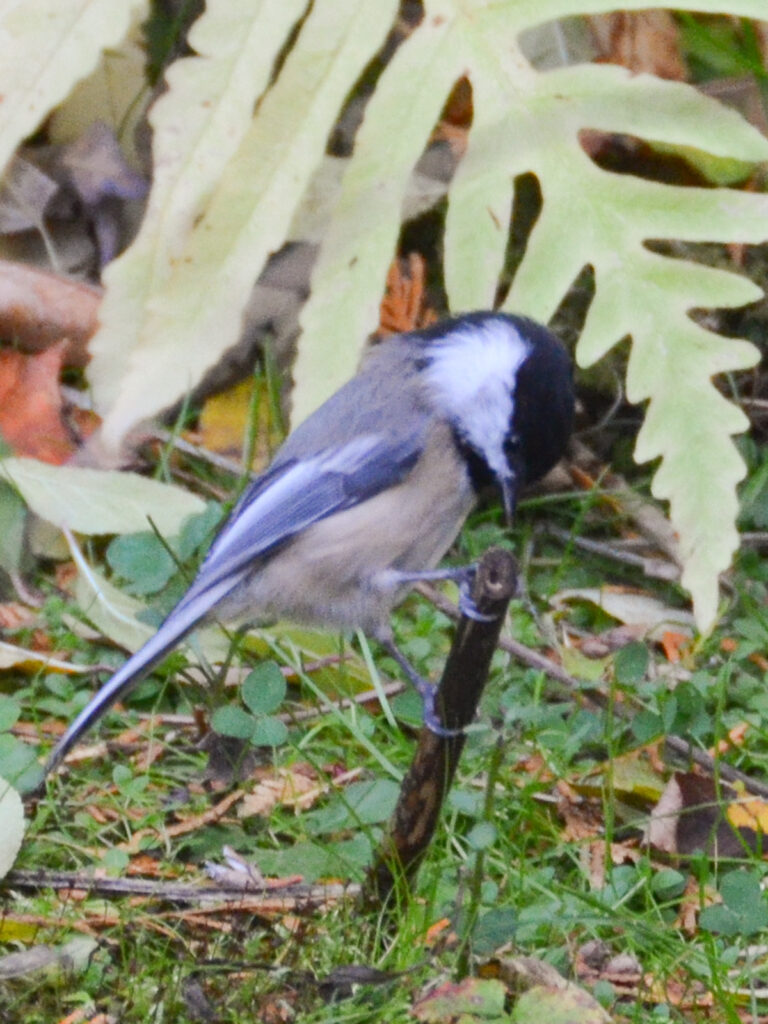
Research has found that northern chickadees may cache perhaps 10,000 food items to get them through the winter — and that their hippocampus (where memories are stored) grows in the winter. Especially interesting is that the hippocampus of northern chickadees grows larger than that of southern chickadees since southern chickadees have fewer days without food available.
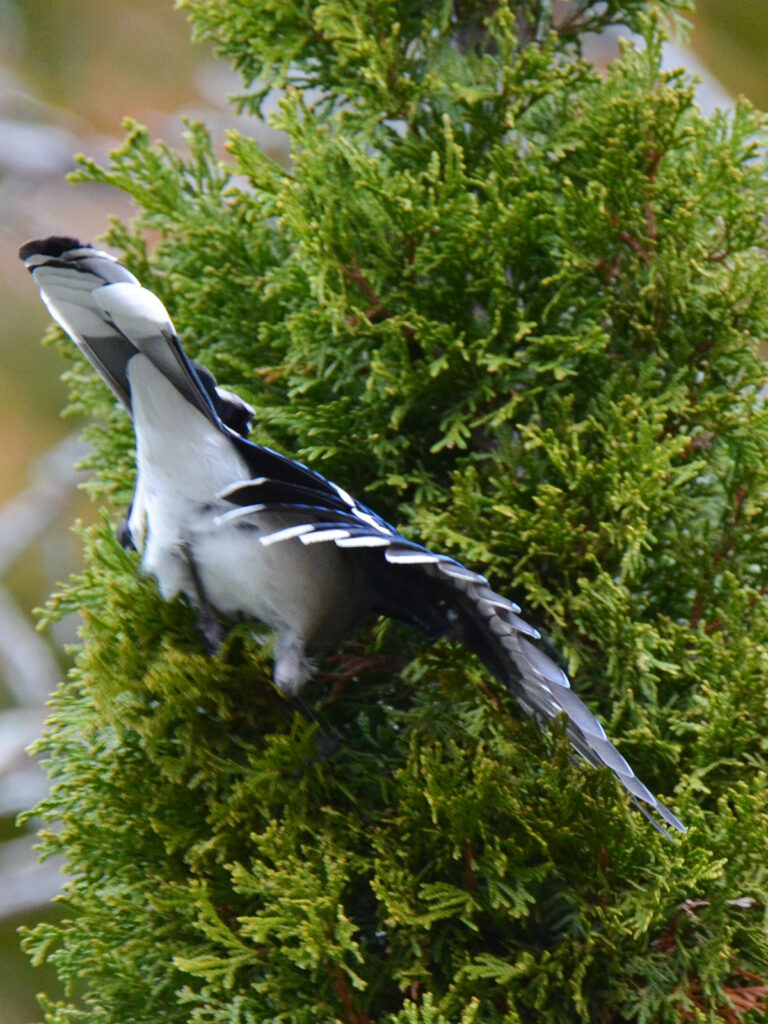
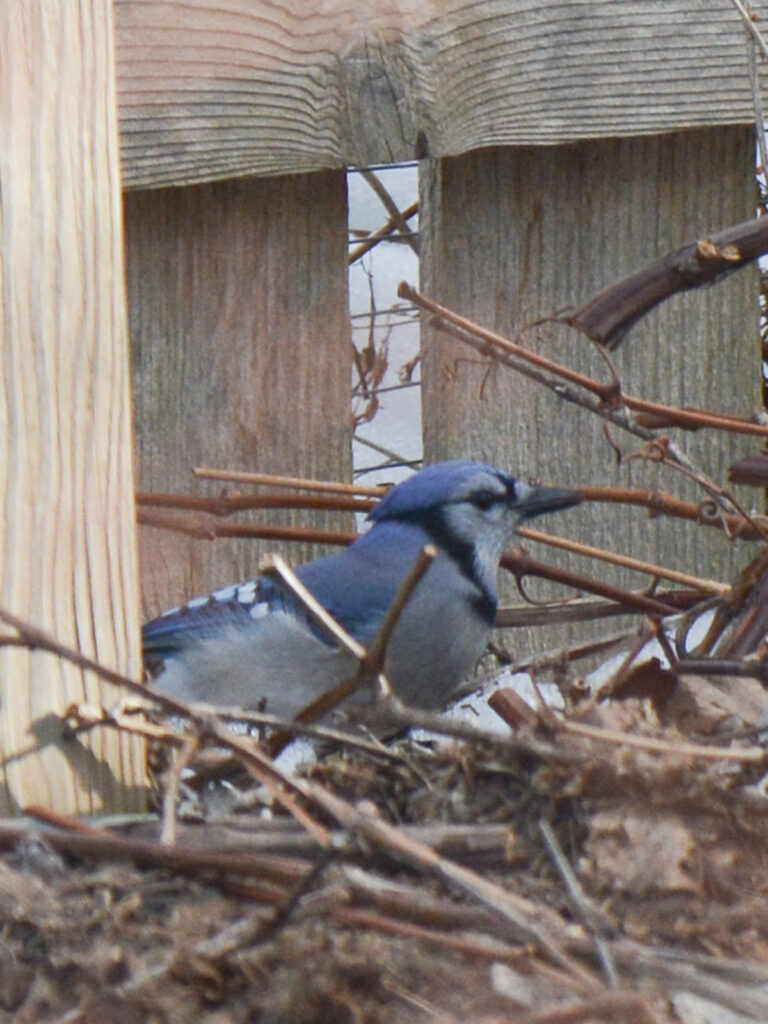
Of course, chickadees aren’t the only birds that cache items away. We’ve also noticed blue jays taking extra peanuts to store away. The most unusual (to us) was sticking them into the top of the arborvitae! More typically, they seem to bury them in the soil and carefully hide them by covering them with soil and leaves.
Interactions with other birds
Defending/fighting
Sometimes birds need to fend off other birds so they make themselves as look bigger and bolder than they usually are.
This catbird heard another catbird in the area and made itself big (and not as beautiful as it usually is) to scare away the competition.
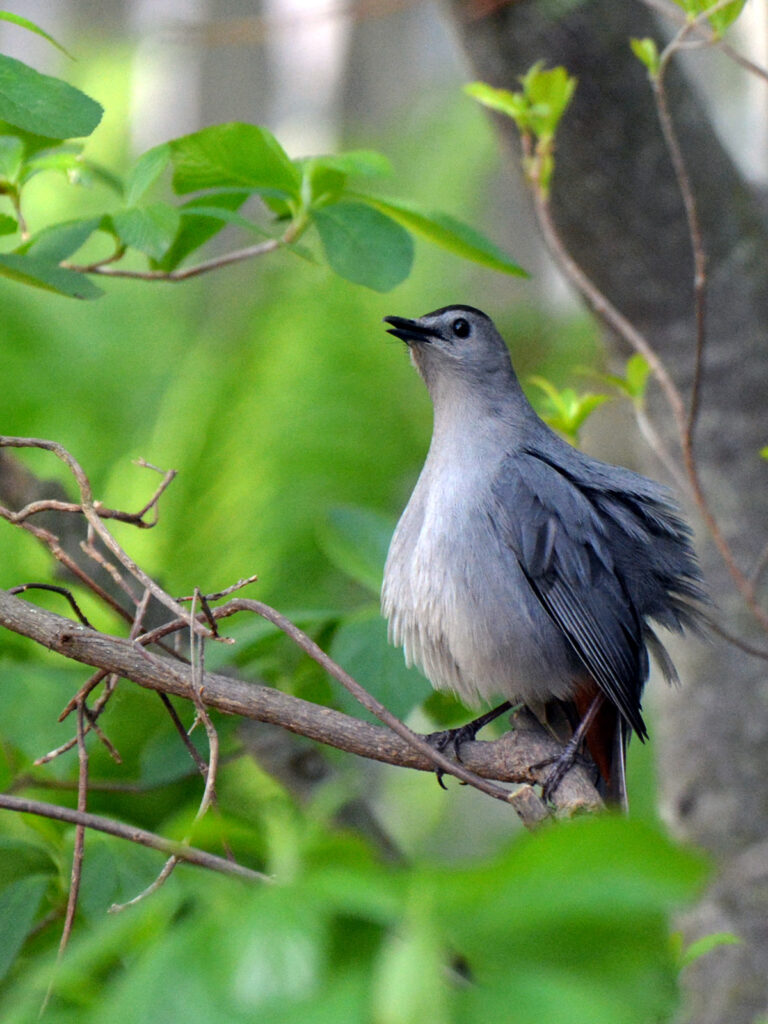
Mobbing
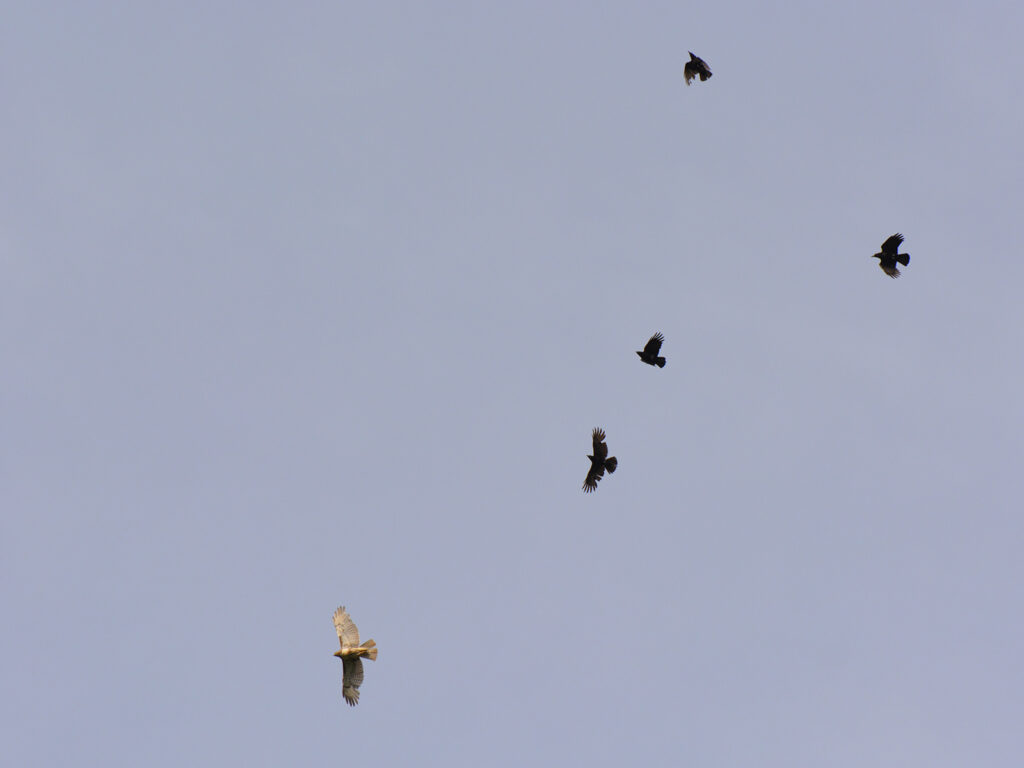
It’s always interesting to see birds working together to escort a predator, such as this hawk, out of the neighborhood.
Scolding people
This wren was raising its babies in a nest box near our laundry area. We have many nest boxes but he chose the one near the laundry dryer! Nevertheless, he objected to me hanging laundry near his babies. He would sit and scold me, even landing on the clothesline to make his point up close and personal. These photos don’t convey their vigorous, fearless scolding that continued until I finished hanging the laundry and left “his” space!
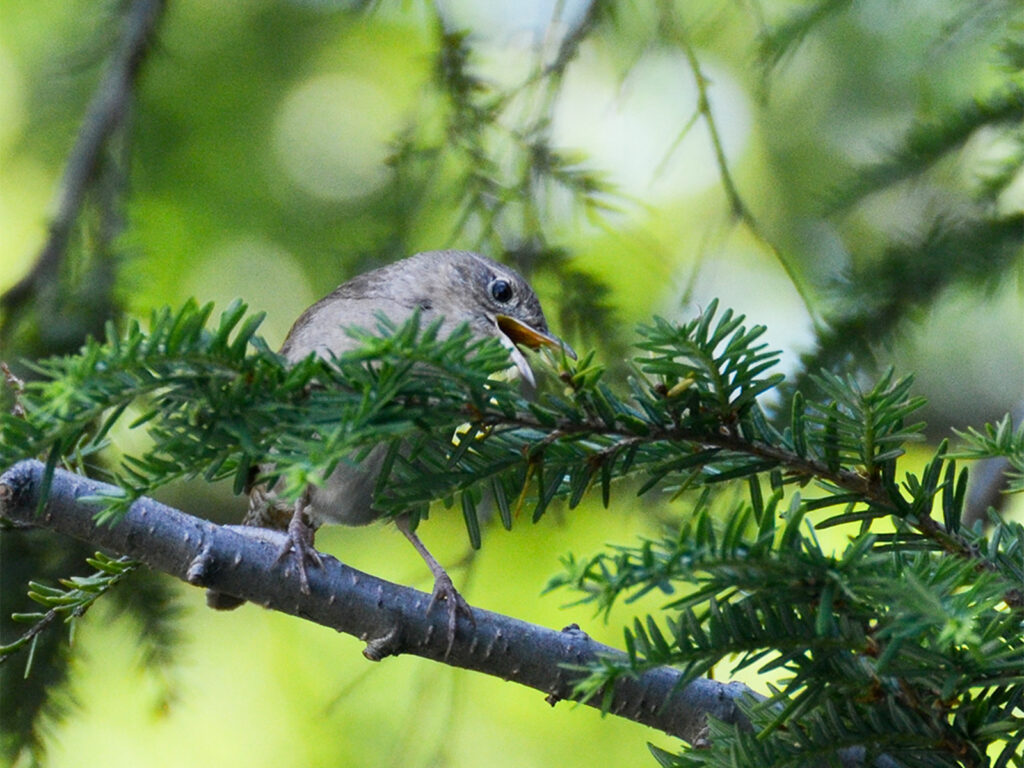
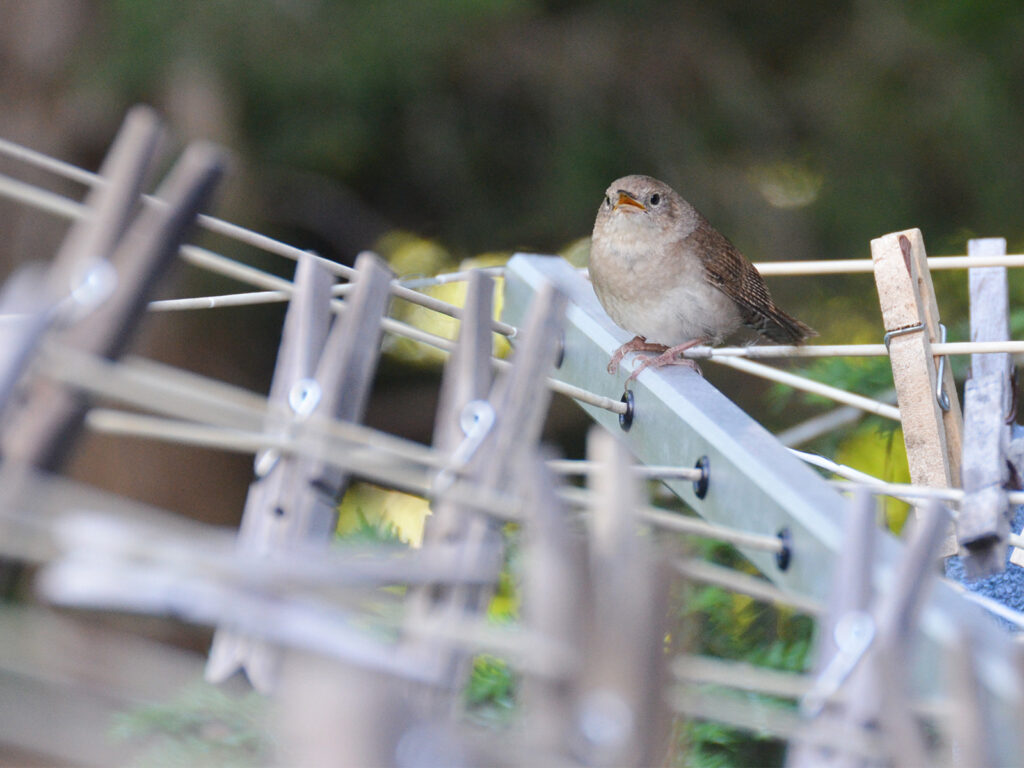
Mourning
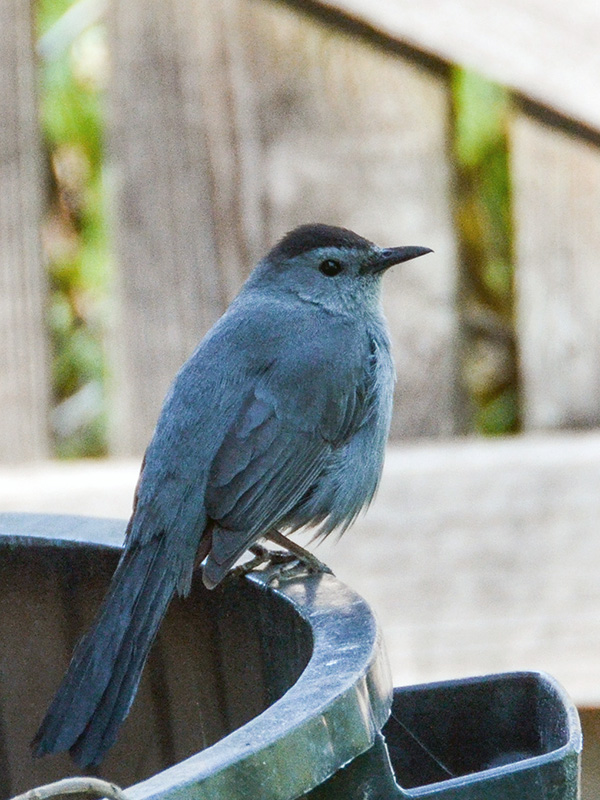
We had a nice little group of catbirds on spring. One of these birds was especially fond of the orange halves I put in the hanging feeder.
Sadly, one day I found one catbird dead in the backyard. (Cats?) In the following days, I never again saw the catbird who loved the oranges, so it must have been that bird that met its demise.
I also saw this catbird sitting in the yard near where the dead bird was. Was it its mate? Just a flock mate? Was it indeed mourning its loss?
Have we taken the “dangers” of anthropomorphism too far? We may be both overestimating the voluntary nature of human behavior and underestimating animal behavior. For example, some research indicates that some aspects of human behavior may be influenced by the composition of our microbiome or by “instinct.” Think of the many behaviors people exhibit in reaction to babies crying, for example.
Might it also be true that wildlife is driven by some degree of emotion, not just instinct?
Migration
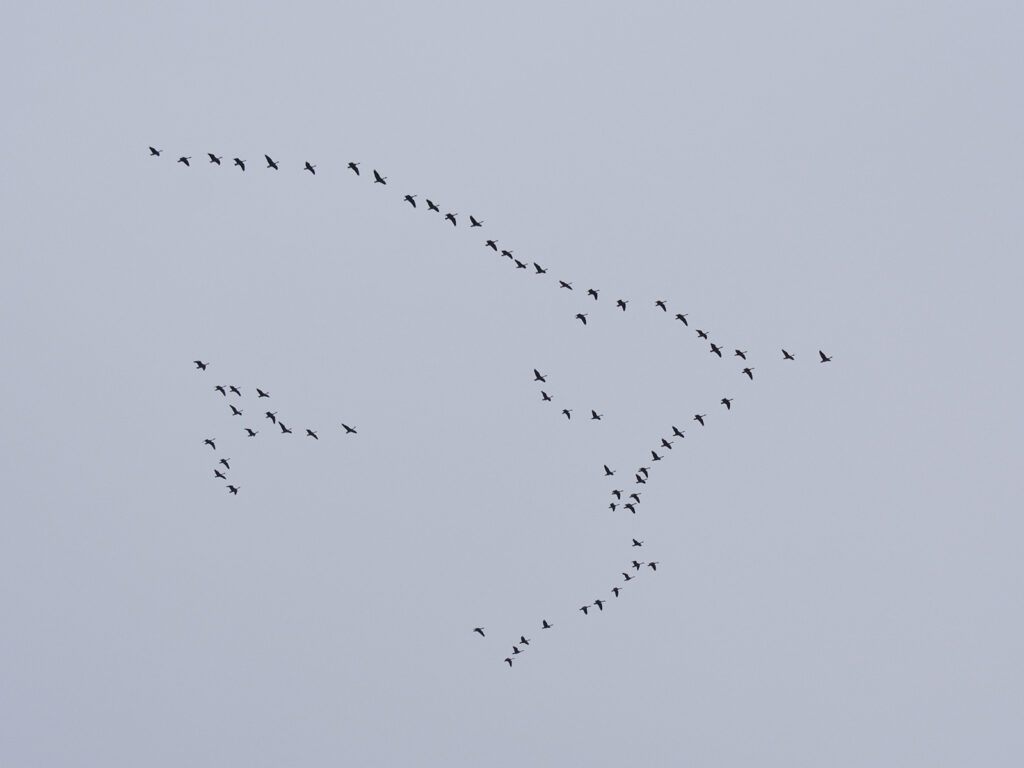
Migration is an amazing phenomenon. It’s most noticeable with geese, but many birds migrate.
The most amazing thing was seeing “my” catbird from the previous summer return in the spring to my yard after overwintering in Florida or the Caribbean.
This is not just any catbird who returned to my yard, but the same exact bird that lived in my yard all last summer.
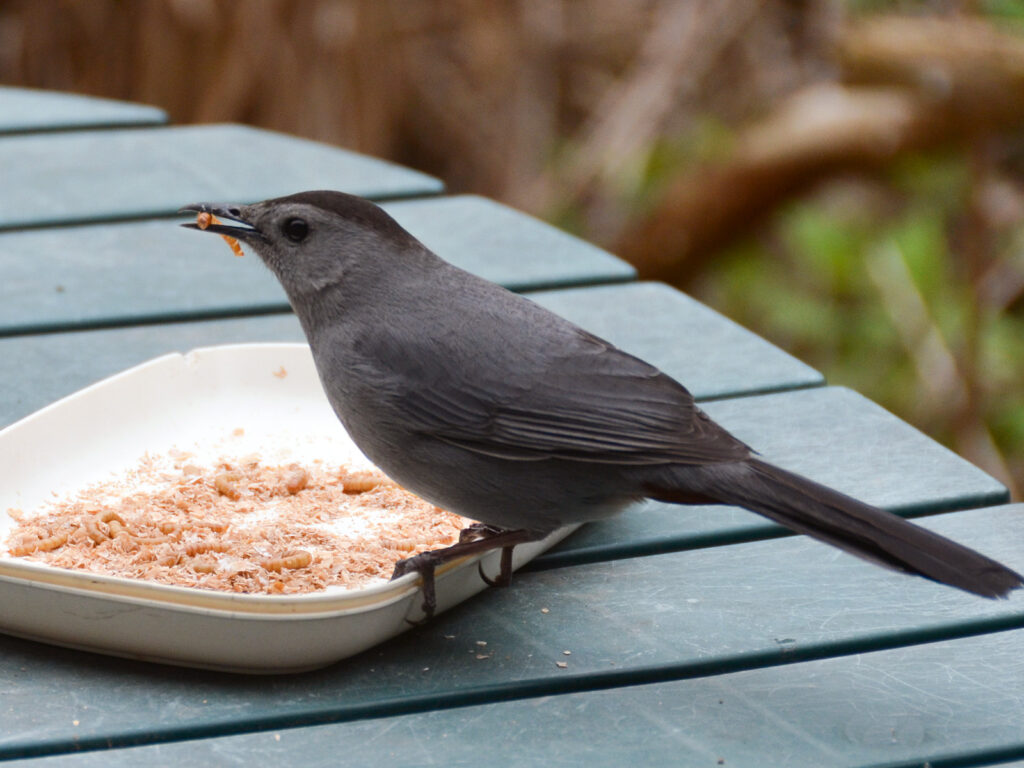
How did I know it was the same bird? It immediately came to the usual green table just outside my sliding door in the back yard and waited for mealworms. Not just waited, but fluttered in front of the bay window when he spotted me inside! He immediately repeated all the routines from the previous year — not something a new bird would do!
Returning to a specific site is not an uncommon behavior, and it has been documented by bird banding records. Could I figure out how to get to Florida and back using just my (not-well-developed) sense of direction? I don’t think so!
I feel sad each year as my catbirds leave, knowing all the dangers they face during the migration down and back and throughout the winter, with fewer and fewer places for them to stay (in part due to our desire for cheap coffee). It’s a joy to see know that some indeed successfully make the round trip.
Resources
- Cornell Lab of Ornithology:
- Where is that bird going with that seed? It’s caching for later
- How a parrot learns its name in the wild
- Play Bird Song Hero – Fun, free game to test your bird song spectrogram skills!
- The Basics: Feather molt
- Power struggles are playing out at your feeders – a short slow-motion video
- BirdCast – Bird migration forecasts in real time – Amazing!!
- The basics of bird migration: How, why, and where – And links to a lot more info, too!
- Mesmerizing migrations: Watch species migrate
- Is bird migration getting more difficult?
- Lights Out – protecting birds during migration
- Bird migration forecast maps – Yes, FORECASTS!
- Alarm calls everyone know: Innate response to unfamiliar calls
- WEBINAR: Practical ways to help birds during migration
- PRESENTATIONS: Open lectures – Recordings of all 2021 Migration Celebration presentations and live event recordings and the Monday Night Seminar series
- Journey North:
- Smithsonian Migratory Bird Institute:
- Bird Notes:
- Slow Birding:
- Blog – A blog and book about the enjoyment of watching bird behavior
- NY Times:
- The Nature Conservancy:
- Audubon:
- Lesley the Bird Nerd (Some of the videos contain ads):
- VIDEO: YouTube channel – Fascinating glimpses into bird behavior
- VIDEO: How do birds survive the cold winter?
- WH Amazing Animals (Contains ads):
- VIDEO: Chickadee Nesting, Breeding And Fledgling – shows inside the nest box!
- Phys.org:
- Hilton Pond Center:
- Birds of a feather: Hummingbird molt – AMAZING photos of a hummingbird molting!
- Two venerable hummingbirds – returning to the exact location for at least six years!
- Do Eastern house finches STILL migrate? (Apparently, they do)
- Bird Watcher’s General Store:
Reflections
Before I tucked the doomed yellow-rumped warbler under a tree, where some hungry scavenger could at least make a meal of it, I studied its curling feet, its flawless plumage. It broke my heart. The only thing wrong with that perfect little bird was our storm door, which had somehow drawn it from its nighttime path.
We’ll never be able to make this house completely safe for our wild neighbors, but that warbler was a reminder to take even more care with lights and glass, especially during the migration seasons. I have no choice but to try. It’s hard enough to feel powerless in the face of the many dangers my own species has created for the species whose ecosystems we share. It’s far worse to feel personally responsible for those dangers, too.
~ Margaret Renkl, NYTimes “Lights out, America! (Songbirds are counting on us)”
Visual Reflections
- Cornell Lab of Ornithology’s All about birds:
- Macaulay Library’s Best Bird Photos 2022
- Bird Cam Highlights: Best of 2018; Best of 2019; Best of 2020
- VIDEO: All Cams; some are live streams, others show interesting moments captured in the past
- Audubon:
- Gorgeous photos of bird behaviors, many of birds I’d never see in my own yard:
